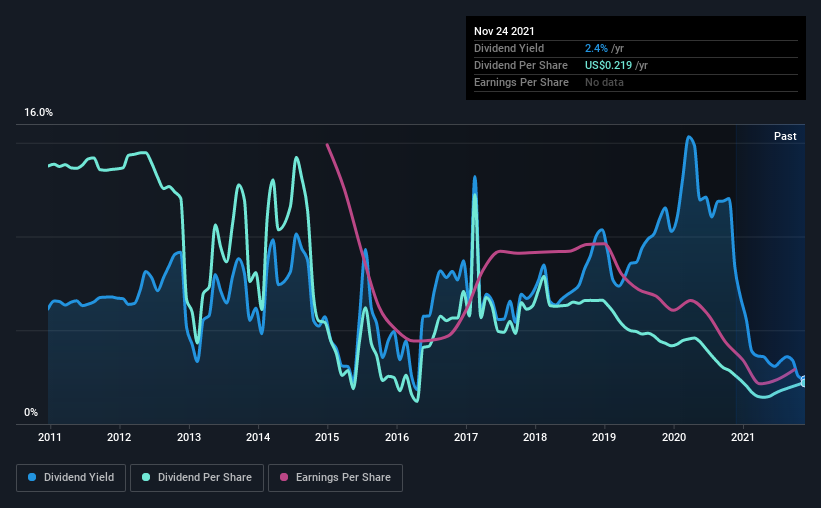Permian Basin Royalty Trust (NYSE:PBT) Will Pay A Larger Dividend Than Last Year At US$0.023
Permian Basin Royalty Trust (NYSE:PBT) has announced that it will be increasing its dividend on the 14th of December to US$0.023, which will be 66% higher than last year. Although the dividend is now higher, the yield is only 2.4%, which is below the industry average.
While the dividend yield is important for income investors, it is also important to consider any large share price moves, as this will generally outweigh any gains from distributions. Investors will be pleased to see that Permian Basin Royalty Trust's stock price has increased by 79% in the last 3 months, which is good for shareholders and can also explain a decrease in the dividend yield.
See our latest analysis for Permian Basin Royalty Trust
Permian Basin Royalty Trust Is Paying Out More Than It Is Earning
If it is predictable over a long period, even low dividend yields can be attractive. Prior to this announcement, the company was paying out 98% of what it was earning, however the dividend was quite comfortably covered by free cash flows at a cash payout ratio of only . Generally, we think cash is more important than accounting measures of profit, so with the cash flows easily covering the dividend, we don't think there is much reason to worry.
If the company can't turn things around, EPS could fall by 9.1% over the next year. If the dividend continues along the path it has been on recently, the payout ratio in 12 months could be 106%, which is definitely a bit high to be sustainable going forward.
Permian Basin Royalty Trust's Track Record Isn't Great
While the company's dividend hasn't been very volatile, it has been decreasing over time, which isn't ideal. Since 2011, the first annual payment was US$1.38, compared to the most recent full-year payment of US$0.22. The dividend has fallen 84% over that period. A company that decreases its dividend over time generally isn't what we are looking for.
Dividend Growth Is Doubtful
Given that the track record hasn't been stellar, we really want to see earnings per share growing over time. Permian Basin Royalty Trust has seen earnings per share falling at 9.1% per year over the last five years. Declining earnings will inevitably lead to the company paying a lower dividend in line with lower profits.
In Summary
In summary, while it's always good to see the dividend being raised, we don't think Permian Basin Royalty Trust's payments are rock solid. The company has been bring in plenty of cash to cover the dividend, but we don't necessarily think that makes it a great dividend stock. We would be a touch cautious of relying on this stock primarily for the dividend income.
Investors generally tend to favour companies with a consistent, stable dividend policy as opposed to those operating an irregular one. Meanwhile, despite the importance of dividend payments, they are not the only factors our readers should know when assessing a company. Just as an example, we've come across 3 warning signs for Permian Basin Royalty Trust you should be aware of, and 1 of them can't be ignored. Looking for more high-yielding dividend ideas? Try our curated list of strong dividend payers.
This article by Simply Wall St is general in nature. We provide commentary based on historical data and analyst forecasts only using an unbiased methodology and our articles are not intended to be financial advice. It does not constitute a recommendation to buy or sell any stock, and does not take account of your objectives, or your financial situation. We aim to bring you long-term focused analysis driven by fundamental data. Note that our analysis may not factor in the latest price-sensitive company announcements or qualitative material. Simply Wall St has no position in any stocks mentioned.
Have feedback on this article? Concerned about the content? Get in touch with us directly. Alternatively, email editorial-team (at) simplywallst.com.

 Yahoo Finance
Yahoo Finance 
